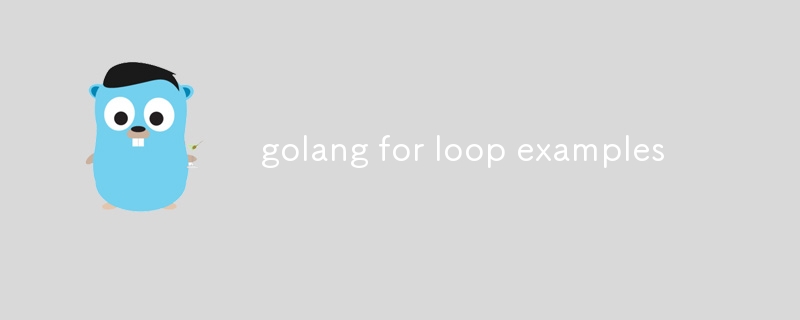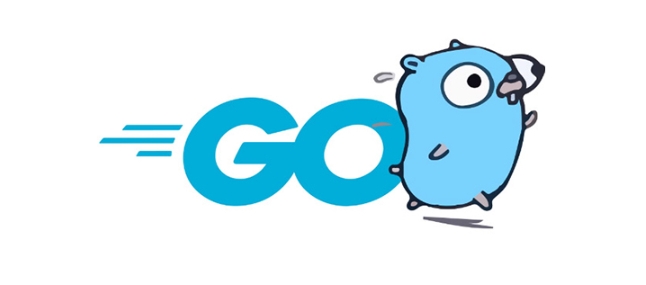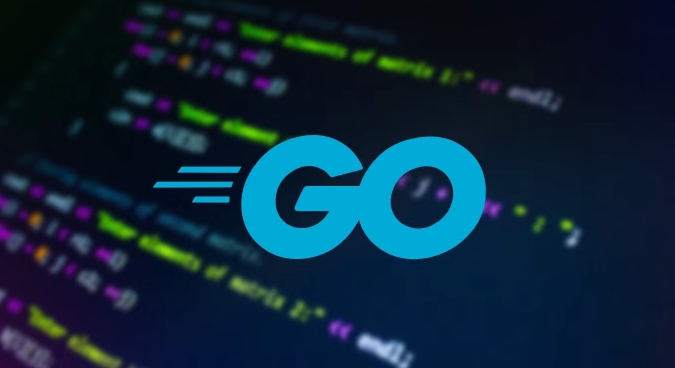The for loop in Go language realizes multiple loop control through a unified structure, and its core is three parts: initialization, conditional judgment and post-operation. 1. The basic structure is suitable for scenarios with known number of loops, such as traversing arrays or slice indexes; 2. Range can traverse collection type data in concisely, which is commonly used to process HTTP request parameters, configuration items and string characters; 3. Go simulates the while loop behavior by omitting initialization and post-statement, and supports infinite loops to cope with polling, listening and other needs; 4.break is used to exit the loop, and continue skips the current iteration. The two need to be used reasonably in nested loops or complex condition filtering to keep the logic clear. Mastering these typical uses can create efficient and easy-to-read Go programs.

for loops in Go are the core structure for handling repeated operations. It does not have multiple loop forms (such as while , do-while ) like other languages, but implements all types of loop control through flexible for syntax. Mastering its use is very important for writing a Go program well.

Basic for loop structure
The basic for loop in Go contains three parts: initialization statement, conditional expression and post-statement. They are separated by semicolons and written in brackets after the for keyword.

for i := 0; i < 5; i {
fmt.Println(i)
} This code prints out numbers from 0 to 4.
in:
-
i := 0is the initialization statement, executed once before the loop starts. -
i < 5is a conditional judgment, and it will be checked before each cycle. -
iis the operation that runs after each cycle body is executed.
This structure is most commonly used in scenarios where the number of loops is known, such as traversing an array or a slice's index.

Iterate over arrays, slices, and strings
In Go, you can use range and for to traverse the data structure of collection type. This method is simple and not prone to errors.
nums := []int{1, 2, 3, 4, 5}
for index, value := range nums {
fmt.Printf("Index: %d, value: %d\n", index, value)
} If you don't need indexes or values, you can use _ the unnecessary parts:
for _, value := range nums {
fmt.Println(value)
}Common uses include:
- List of parameters for processing HTTP requests
- Traversal configuration items
- String characters are processed one by one
When traversing a string, value will be of type rune , which is suitable for processing multi-byte characters such as Chinese.
Simulate the behavior of while loops
Go does not have a separate while keyword, but similar behavior can be simulated by omitting initialization and post-statements:
i := 0
for i < 5 {
fmt.Println(i)
i
}This is equivalent to other languages:
let i = 0;
while (i < 5) {
console.log(i);
i ;
}You can also construct an infinite loop:
for {
// Execute some logic if someCondition {
break
}
}This situation is often used in scenarios where polling, listening to events, reading stream data, etc. need to be continuously run.
Control loop flow: break and continue
In the loop body, break is used to exit the loop early, while continue skips the current iteration and goes directly to the next round.
For example:
for i := 0; i < 10; i {
if i%2 == 0 {
Continue continue
}
fmt.Println(i) // Print only odd numbers}Some practical tips:
-
breakout of outer loop using tagged break in nested loop - Use
continueto skip invalid or unprocessed data - Complex condition filtering with
switchstatement
Be careful not to abuse break and continue , otherwise the logic will be difficult to understand.
Basically these common uses. Although Go's for loop is unified in form, it is flexible enough to adapt to most scenarios. As long as you are familiar with several typical writing methods, you can write clear and efficient circular logic.
The above is the detailed content of golang for loop examples. For more information, please follow other related articles on the PHP Chinese website!

Hot AI Tools

Undress AI Tool
Undress images for free

Undresser.AI Undress
AI-powered app for creating realistic nude photos

AI Clothes Remover
Online AI tool for removing clothes from photos.

Clothoff.io
AI clothes remover

Video Face Swap
Swap faces in any video effortlessly with our completely free AI face swap tool!

Hot Article

Hot Tools

Notepad++7.3.1
Easy-to-use and free code editor

SublimeText3 Chinese version
Chinese version, very easy to use

Zend Studio 13.0.1
Powerful PHP integrated development environment

Dreamweaver CS6
Visual web development tools

SublimeText3 Mac version
God-level code editing software (SublimeText3)

Hot Topics
 What are the implications of Go's static linking by default?
Jun 19, 2025 am 01:08 AM
What are the implications of Go's static linking by default?
Jun 19, 2025 am 01:08 AM
Go compiles the program into a standalone binary by default, the main reason is static linking. 1. Simpler deployment: no additional installation of dependency libraries, can be run directly across Linux distributions; 2. Larger binary size: Including all dependencies causes file size to increase, but can be optimized through building flags or compression tools; 3. Higher predictability and security: avoid risks brought about by changes in external library versions and enhance stability; 4. Limited operation flexibility: cannot hot update of shared libraries, and recompile and deployment are required to fix dependency vulnerabilities. These features make Go suitable for CLI tools, microservices and other scenarios, but trade-offs are needed in environments where storage is restricted or relies on centralized management.
 How do I create a buffered channel in Go? (e.g., make(chan int, 10))
Jun 20, 2025 am 01:07 AM
How do I create a buffered channel in Go? (e.g., make(chan int, 10))
Jun 20, 2025 am 01:07 AM
To create a buffer channel in Go, just specify the capacity parameters in the make function. The buffer channel allows the sending operation to temporarily store data when there is no receiver, as long as the specified capacity is not exceeded. For example, ch:=make(chanint,10) creates a buffer channel that can store up to 10 integer values; unlike unbuffered channels, data will not be blocked immediately when sending, but the data will be temporarily stored in the buffer until it is taken away by the receiver; when using it, please note: 1. The capacity setting should be reasonable to avoid memory waste or frequent blocking; 2. The buffer needs to prevent memory problems from being accumulated indefinitely in the buffer; 3. The signal can be passed by the chanstruct{} type to save resources; common scenarios include controlling the number of concurrency, producer-consumer models and differentiation
 How does Go ensure memory safety without manual memory management like in C?
Jun 19, 2025 am 01:11 AM
How does Go ensure memory safety without manual memory management like in C?
Jun 19, 2025 am 01:11 AM
Goensuresmemorysafetywithoutmanualmanagementthroughautomaticgarbagecollection,nopointerarithmetic,safeconcurrency,andruntimechecks.First,Go’sgarbagecollectorautomaticallyreclaimsunusedmemory,preventingleaksanddanglingpointers.Second,itdisallowspointe
 How can you use Go for system programming tasks?
Jun 19, 2025 am 01:10 AM
How can you use Go for system programming tasks?
Jun 19, 2025 am 01:10 AM
Go is ideal for system programming because it combines the performance of compiled languages ??such as C with the ease of use and security of modern languages. 1. In terms of file and directory operations, Go's os package supports creation, deletion, renaming and checking whether files and directories exist. Use os.ReadFile to read the entire file in one line of code, which is suitable for writing backup scripts or log processing tools; 2. In terms of process management, the exec.Command function of the os/exec package can execute external commands, capture output, set environment variables, redirect input and output flows, and control process life cycles, which are suitable for automation tools and deployment scripts; 3. In terms of network and concurrency, the net package supports TCP/UDP programming, DNS query and original sets.
 How do I call a method on a struct instance in Go?
Jun 24, 2025 pm 03:17 PM
How do I call a method on a struct instance in Go?
Jun 24, 2025 pm 03:17 PM
In Go language, calling a structure method requires first defining the structure and the method that binds the receiver, and accessing it using a point number. After defining the structure Rectangle, the method can be declared through the value receiver or the pointer receiver; 1. Use the value receiver such as func(rRectangle)Area()int and directly call it through rect.Area(); 2. If you need to modify the structure, use the pointer receiver such as func(r*Rectangle)SetWidth(...), and Go will automatically handle the conversion of pointers and values; 3. When embedding the structure, the method of embedded structure will be improved, and it can be called directly through the outer structure; 4. Go does not need to force use getter/setter,
 What are interfaces in Go, and how do I define them?
Jun 22, 2025 pm 03:41 PM
What are interfaces in Go, and how do I define them?
Jun 22, 2025 pm 03:41 PM
In Go, an interface is a type that defines behavior without specifying implementation. An interface consists of method signatures, and any type that implements these methods automatically satisfy the interface. For example, if you define a Speaker interface that contains the Speak() method, all types that implement the method can be considered Speaker. Interfaces are suitable for writing common functions, abstract implementation details, and using mock objects in testing. Defining an interface uses the interface keyword and lists method signatures, without explicitly declaring the type to implement the interface. Common use cases include logs, formatting, abstractions of different databases or services, and notification systems. For example, both Dog and Robot types can implement Speak methods and pass them to the same Anno
 How do I use string functions from the strings package in Go? (e.g., len(), strings.Contains(), strings.Index(), strings.ReplaceAll())
Jun 20, 2025 am 01:06 AM
How do I use string functions from the strings package in Go? (e.g., len(), strings.Contains(), strings.Index(), strings.ReplaceAll())
Jun 20, 2025 am 01:06 AM
In Go language, string operations are mainly implemented through strings package and built-in functions. 1.strings.Contains() is used to determine whether a string contains a substring and returns a Boolean value; 2.strings.Index() can find the location where the substring appears for the first time, and if it does not exist, it returns -1; 3.strings.ReplaceAll() can replace all matching substrings, and can also control the number of replacements through strings.Replace(); 4.len() function is used to obtain the length of the bytes of the string, but when processing Unicode, you need to pay attention to the difference between characters and bytes. These functions are often used in scenarios such as data filtering, text parsing, and string processing.
 How do I use the io package to work with input and output streams in Go?
Jun 20, 2025 am 11:25 AM
How do I use the io package to work with input and output streams in Go?
Jun 20, 2025 am 11:25 AM
TheGoiopackageprovidesinterfaceslikeReaderandWritertohandleI/Ooperationsuniformlyacrosssources.1.io.Reader'sReadmethodenablesreadingfromvarioussourcessuchasfilesorHTTPresponses.2.io.Writer'sWritemethodfacilitateswritingtodestinationslikestandardoutpu






